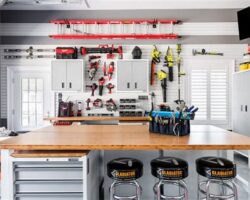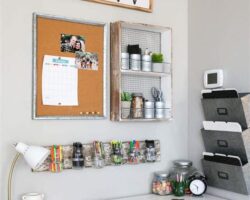Are you finding yourself in need of a dedicated workspace that serves multiple purposes? As the lines between work and home life continue to blur, it’s becoming increasingly important to create a multifunctional space that balances both productivity and comfort. In this blog post, we will explore the steps to creating a versatile workshop and home office that meets your specific needs and priorities. From assessing your space and requirements to choosing the right furniture and equipment, we’ll cover everything you need to know to design a space that maximizes storage, organization, and productivity. By incorporating inspiring and creative elements, as well as setting boundaries for work-life balance, you can create a space that not only supports your work endeavors but also enhances your overall well-being. Let’s dive into the process of designing a multifunctional space that seamlessly integrates work and home life.
Assessing your needs and priorities
Before embarking on a home office makeover, it’s important to assess your needs and priorities. Consider the type of work you do and what tools and equipment are necessary for optimal productivity. Are you in need of a quiet space for focused work, or do you require an area for collaboration and meetings? Understanding your specific needs will guide the design and layout of your home office.
Another important aspect to consider is ergonomics. Assess your posture and comfort during prolonged periods of work. Ensuring that your desk, chair, and other furniture are designed with proper ergonomics in mind can prevent discomfort and injury in the long run.
Additionally, technology needs should be evaluated. Do you require a dedicated space for multiple monitors, printers, or other devices? Understanding your technological needs will help determine the layout and organization of your home office.
Finally, take into account any storage requirements. Assess the amount of physical and digital storage space needed to keep your workspace clutter-free and organized. Consider your filing system, shelving, and other storage solutions that align with your needs and priorities.
Designing a versatile layout
When designing a versatile layout for your workspace, it’s important to consider the different functions and activities that will take place in the area. Whether it’s for a home office or a commercial space, the layout should be able to accommodate various tasks such as typing, writing, meeting with clients, and storage.
One way to create a versatile layout is by using modular furniture and fixtures that can be easily reconfigured to suit different needs. This allows for flexibility and adaptability, which are essential in a dynamic work environment.
Another consideration is the flow of the space, ensuring that there’s enough room to move around comfortably and access all necessary work tools and equipment. This can be achieved by strategically placing workstations, storage units, and seating areas.
Lastly, incorporating multi-functional pieces such as desks with built-in shelves, or tables with retractable sections, can help save space and maximize efficiency in a versatile layout.
Choosing the right furniture and equipment
When setting up your workspace, it’s crucial to consider furniture and equipment that will best suit your needs and optimize productivity. It’s important to choose ergonomic and comfortable office chairs and desks that will support good posture and reduce the risk of developing back problems. Additionally, investing in adjustable standing desks can offer flexibility and improve circulation, reducing the negative effects of prolonged sitting.
Lighting plays a significant role in creating a conducive work environment. Natural light is preferable, so positioning your workspace near a window or investing in full-spectrum lighting can help reduce eye strain and improve mood and productivity. In terms of equipment, it’s essential to select reliable and high-quality technology such as computers, printers, and other devices that will enhance efficiency and minimize downtime caused by equipment failure.
Considering storage solutions is also crucial when selecting furniture and equipment. Opt for desks and cabinets with ample storage space to keep your workspace organized and clutter-free. A clutter-free environment can help reduce distractions and enhance focus, ultimately improving productivity and job satisfaction. Additionally, incorporating ergonomic accessories such as monitor stands, keyboard trays, and cable management systems can contribute to a more organized and efficient workspace.
In conclusion, choosing the right furniture and equipment for your workspace is a vital aspect of creating a productive and comfortable work environment. By prioritizing ergonomics, comfort, and functionality, you can ensure that your workspace is conducive to efficient work and supports your overall well-being.
Maximizing storage and organization
When it comes to creating an efficient and productive work environment, maximizing storage and organization is crucial. Whether you’re working from home or in a traditional office setting, having a designated space for all your tools, documents, and supplies can make a significant difference in your daily work flow.
One of the most important aspects of maximizing storage and organization is making the most out of your available space. This may involve investing in space-saving furniture such as wall-mounted shelves, under-desk storage units, or multi-functional workstations that offer built-in storage solutions.
In addition to utilizing furniture with built-in storage, incorporating storage containers and organizers can help keep your workspace tidy and efficient. Clear plastic bins, drawer dividers, and desk organizers are all great tools for keeping your supplies easily accessible while maintaining a clutter-free environment.
When organizing your workspace, it’s important to label and categorize all of your items. Whether it’s filing cabinets, storage boxes, or shelves, clearly labeling each storage unit will save you time and frustration when trying to locate specific items.
Creating a productive work environment
Creating a productive work environment is essential for maintaining focus and achieving success in your professional life. It involves several key factors including lighting, comfortable seating, and minimal distractions. These are all essential components that contribute to an environment that promotes efficiency and creativity.
One of the most important aspects of creating a productive work environment is the layout of the space. It should be organized in a way that allows for easy movement and accessibility. This could involve positioning your desk and chair in a way that maximizes comfort and functionality. Additionally, incorporating plants and natural elements into your workspace can have a positive impact on your mood and productivity.
Another key factor in creating a productive work environment is setting boundaries for work-life balance. It’s important to establish dedicated work hours and stick to them. This helps in avoiding burnout and ensures that you’re able to relax and recharge outside of work hours. This also involves avoiding the temptation to work in areas of your home that are meant for relaxation, such as the bedroom or living room.
Overall, creating a productive work environment involves careful consideration of various factors such as lighting, layout, comfort, and boundaries. By paying attention to these elements, you can foster an environment that promotes efficiency, creativity, and overall well-being.
Setting boundaries for work-life balance
When working from home, it can be challenging to separate your personal and professional life. It’s important to establish clear boundaries to maintain a healthy work-life balance. One way to do this is to set specific work hours and stick to them. This means logging off at a designated time each day and not checking work emails or taking work calls outside of those hours.
Another key factor in setting boundaries for work-life balance is creating a designated workspace. This could be a separate room, a corner of a room, or even just a specific desk or table. The idea is to have a physical space that is associated with work, which you can then leave when you’re done for the day.
It’s also important to communicate your boundaries with family members or roommates who share your living space. Let them know when you’re working and ask for their support in respecting your work hours and space. And on the flip side, make sure to also set boundaries for yourself to avoid overworking and burning out.
Setting boundaries for work-life balance also involves being intentional about taking time for self-care and personal activities. This means scheduling regular breaks, exercise, leisure time, and socializing, and treating these activities with the same priority as work. By clearly defining your work hours, physical workspace, and personal time, you can achieve a better balance between your professional and personal life.
Incorporating inspiring and creative elements
When it comes to designing a home office, it’s important to incorporate inspiring and creative elements that can enhance productivity and motivation. One way to achieve this is by adding artwork or motivational quotes to the walls of your workspace. Surrounding yourself with visual reminders of your goals and aspirations can help keep you focused and driven.
Another way to incorporate inspiring and creative elements into your home office is by adding plants or natural elements. Research has shown that adding greenery to a workspace can improve air quality and reduce stress, creating a more positive and productive environment. Additionally, bringing elements of nature indoors can help to inspire creativity and innovation.
Consider incorporating unique and personalized decor items into your home office, such as a statement rug or an eye-catching light fixture. These small details can add personality to your space and serve as a source of inspiration. By surrounding yourself with items that reflect your personal style and interests, you can create a workspace that is truly inspiring.
Ultimately, incorporating inspiring and creative elements into your home office is a highly personal process. Whether it’s through artwork, natural elements, or unique decor items, the goal is to create a space that motivates and energizes you. By taking the time to curate a workspace that reflects your personality and values, you can foster a more productive and fulfilling work environment.





